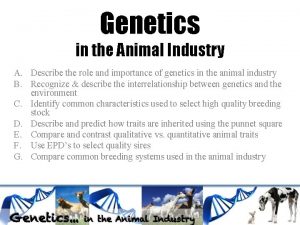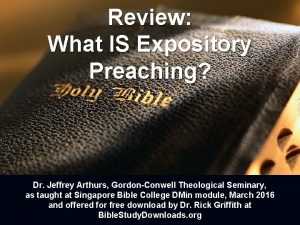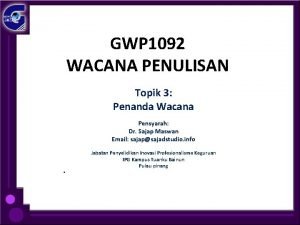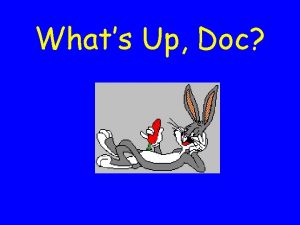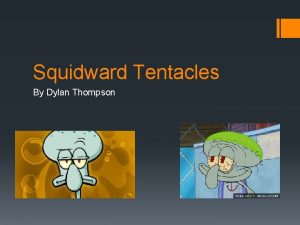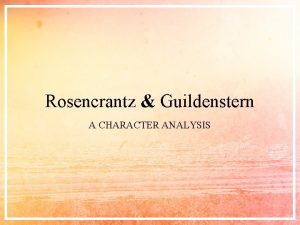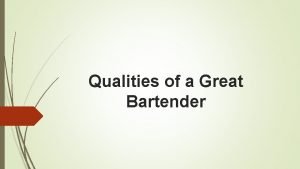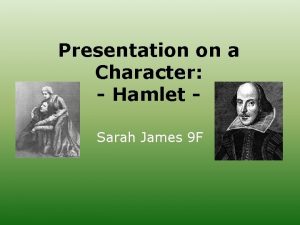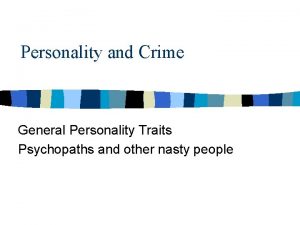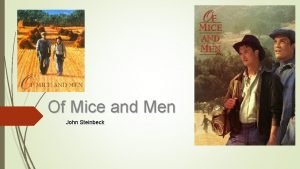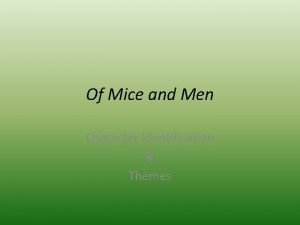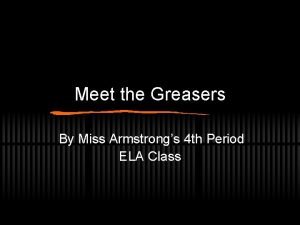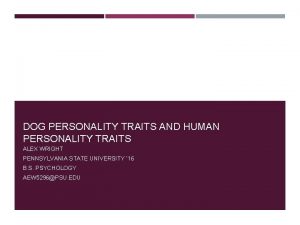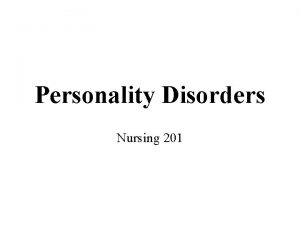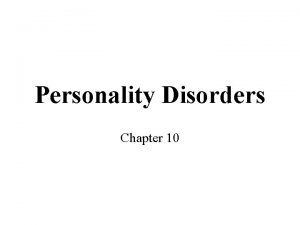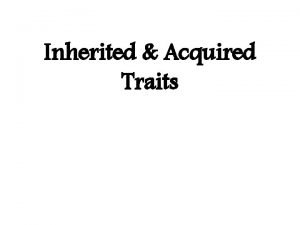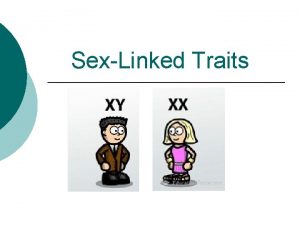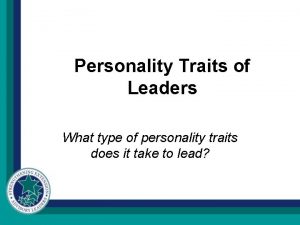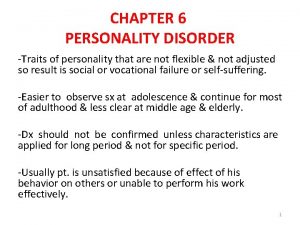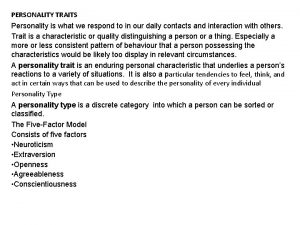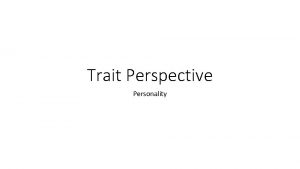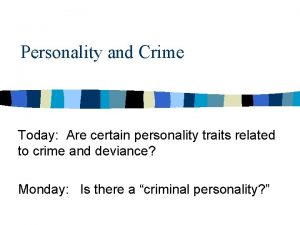Introduction to Personality the idea of personality traits



































- Slides: 35

Introduction to Personality • “the idea of personality traits may be as old as human language itself” • Aristotle (384 -322 BC) writing about ethics – talked about vanity, modesty, and cowardice as determinants of moral behavior. • His student Theophrastus (371 -287 BC) described 30 characters or personality types. Matthews, Deary, & Whiteman, 2003

Definition • Personality psychology = “analyzing the nature of human nature” (Hogan, 1998, p. 152) • “Personality psychology can be defined as the empirical analysis of the nature of human nature” (p. 153) • “Personality is generally defined as a consistent pattern of behaviors across time” (Heiss & Kurek, 2003, p. 129). • “a comprehensive classification of personality traits in terms of five broad dimensions” (Mc. Crae, 2006, in Strack, p. 51)

What are traits • Two aspects of personality: – Traits – Types – tendency to categorize, group together individuals of similar disposition (Matthews, Deary, & Whiteman, 2003)

What are traits • “disposition to behave” following “consistent patterns of functioning across a range of situations” (Pervin, 1994, p. 108)

Traits vs. States • States – time bound even if time boundaries vary. Include moods (more diffuse, no defining object) and emotions (“affective states that are connected to objects or circumstances” p. 122). • Personality Traits – “an attribute of a person that has no built in time frame, no “on and off” element” (p. 125) • “State variables, by definition, come and go. Trait variables, by definition, do not” (p. 125. ) Heiss, H. ; Kurek, K. , 2003

Traits vs. Adaptations • A trait is “relatively enduring and pervasive dispositions to act, think, and feel in consistent and characteristic ways” (Mc. Crae, 2006, in Strack, p. 53) • Traits are “biologically based basic tendencies that interact with external influences over time to create characteristic adaptations” (Mc. Crae, 2006, in Strack, p. 53). – These adaptations are skills, interests, roles, habits, and attitudes, revealed by both traits and opportunities provided by the environment (Mc. Crae, 2006, in Strack).

Characteristics of Traits • Normally distributed (Howard & Howard, 1995) • Quasinormally distributed (Mc. Crae, 2006, in Strack, p. 53)

History of traits • Earliest progenitors of current trait theories: – Hippocrates (ca. 460 -377 BC) • Theory of Humors – Bodily fluids – to explain disease – – Blood Phlegm Black bile Yellow bile • Galen – – – – Humors became bases of temperament Melancholic (low mood) Choleric (anger) Phlegmatic (calm) Sanguine (optimistic, confident) When blended, balanced fashion, optimum temperament When imbalanced lead to illness and mental disturbance. Matthews, Deary & Whiteman, 2003

What is the Big Five • A “descriptive taxonomy” empirically based (Saucier & Goldberg, p. 21).

FFM History • Already Sir Francis Galton (1884) hypothesized that “individual differences in personality might be represented in natural language terms” (Matthews, Deary, and Whiteman, 2003, p. 10). • Allport & Odpert catalogued 18, 000 words from Webster’s Second International Dictionary on characteristics distinguishing one human being from another (Saucier & Goldberg, 2003). • Factor analyses basic to reduce personality descriptions into manageable number of traits/factors (Matthews, Deary, and Whiteman, 2003)

FFM History – Lexical Approach • All languages include words that encompass personality traits (Howard & Howard, 1995) • Dictionary provided early personality researchers with “raw materials” for early analysis of traits (Matthews, Deary & Whiteman, 2003). • Lexical approach sought to find clusters of personality descriptors in everyday language (Matthews, Deary, and Whiteman, 2003).

FFM History – Lexical Approach • “some of the most basic personality attributes might be discovered from studying conceptions implicit in the use of the natural language” (p. 5) • “if a distinction is highly represented in the lexicon, it can be presumed to have practical importance” (p. 5) • If a concept is salient in the lexicon it should not be left out of a taxonomy of personality attributes. • Key premise of the lexical approach: “the degree of representation of an attribute in language has some correspondence with the general importance of the attribute in real world transactions” (p. 5) • Languages are a good “starting point” especially if many languages are studied (p. 5). Saucier & Goldberg, 2003

Consensus on the Big Five • Consensus – Barrick, Mitchell, and Stewart, 2003 • “the most influential personality model of the past two decades” (Saucier & Goldberg, 2003, p. 6) • “Evidence is accumulating which suggests that virtually all personality measures can be reduced or categorized under the umbrella of the five factors model of personality” (Judge, Higgins, Thoresen, Barrick, 1999, p. 623). • “The FFM provided a much needed empirically validated schema for classifying personality measures and imposing order on the confusing mass of personality job-performance literature” (Walsh & Eggerth, 2005, p. 268)

Consensus on the Big Five • “The FFM is currently the most widely accepted theory of the structure (of) personality” (Walsh & Eggerth, 2005, p. 269)

Why does it matter? • “Virtually all public policy is predicated on assumptions about human nature” (Hogan, 1998, p. 152)

Genetics • Temperament – Biological basis of personality • Even though traumatic life events can impact personality through its impact on the brain – “Personality traits are more expressions of human biology than expressions of life experience” (p. 177) – “biologically based psychological tendencies” (p. 173) Mc. Crae, Hyebickova, Ostendork, Angleitner, Avia, Sanz, Sanchez-Bernardos, 2000

Cultural Context • “Personality traits are more or less immune to environmental influences” (p. 175) • “Environmental influences shared by children in the same family have little or no effect on adult personality (p. 176) • The environment has to do with the expression and adaptation of personality traits more than with the traits themselves. The “trait manifestations must fit within a cultural context” (p. 175) – For instance, an A+ may or may not express sympathy for the dead according to cultural norms that permit or not such sympathy to be openly expressed. – Another example: Personality traits will determine whether a person is more likely to worry, but the cultural context determines what the person worries about: For instance, anxious Americans may worry about social security, a Navajo warrior may worry about ghosts and witches. Mc. Crae, Hyebickova, Ostendork, Angleitner, Avia, Sanz, Sanchez-Bernardos, 2000

Stability • Personality is stable over time (Mc. Crae, Hyebickova, Ostendork, Angleitner, Avia, Sanz, Sanchez-Bernardos, 2000) • Stability is a key assumption made about personality traits, even though there may be some variation according to the situation. There is a perceived “core of consistency” (p. 3) like “the unchangeable spots of the leopard” (p. 3). This makes traits different from changeable moods (Matthews, Deary, & Whiteman, 2003).

Cross Cultural Generalizability • “Psychology is the study of mind and behavior of humans in general, not just of humans in a narrow range of socio-cultural settings” (Saucier & Goldberg, 2003, p. 5). • Problem: so far studies supportive of Big Five in Northern European languages, studies in Italian found no counterpart to intellect – more studies needed in non Western settings (Saucier & Goldberg, 2003).

Causal Primacy • “causal primacy of traits” (Matthews, Deary, & Whiteman, 2003, p. 6) • “the dominant direction of causality is from trait to behavior” (Matthews, Deary, & Whiteman, 2003, p. 6)

Need for Stability • Negative Emotionality (Howard & Howard, 1995) – reactive, experience more negative emotions, report less satisfaction with life. • Saucier & Goldberg, 2003 – “Emotional Stability” (6) • Walsh & Eggerth, 2005 – – “Emotional Stability” (p. 269) – Calm, composed, poised, resilient, adaptable, self reliant

Extraversion • “Extraverts tend to lead, talk, and exert themselves physically more often than other people” (Howard & Howard, 1995, p. 31). Introverts more reserved, comfortable with solitude. • Sociable, gregarious, talkative, assertive, adventurous, active, energetic, ambitious (Walsh & Eggerth, 2005)

Openness • Howard & Howard, 1995: – “range of interests” (p. 31) – Explorers are “fascinated by novelty and innovation” (p. 31) – People with high Originality describe themselves as more introspective and reflective. – Preservers have narrower interests, are more conventional • Walsh & Eggerth, 2005 – Openness to Experience – Imaginative, artistically sensitive, intellectual, curious, original, broad interests • Saucier & Goldberg (2003) – Intellect

Agreeableness • Howard & Howard, 1995: – “person’s propensity to defer to others” (p. 21) – Adapters defer to many – prize harmony more than having their say – Challengers focus more on own norms and needs, want more power • Term also used by Walsh & Eggerth, 2005 • Howard & Howard, 2001 – Accommodation • Walsh & Eggerth, 2005 – Courteous, good natured, flexible, trusting, cooperative, forgiving, empathic, caring, soft hearted, and tolerant

Conscientiousness • Term also used by Walsh & Eggerth, 2005 • Howard & Howard, 2001 – Consolidation • Walsh & Eggerth, 2005 – Careful, thorough, responsible, organized, efficient, persevering, hard working, achievement oriented, dependability, achievement.

What do scores mean? • “It is important to emphasize that the negative poles of the FFM dimensions do not necessarily indicate pathology. Rather, they represent different constellations of response tendencies which depending on circumstances, can lead to beneficial or harmful consequences” (Walsh & Eggerth, 2005, p. 269). • All FFM values, when extreme, “hold the seeds of dysfunction” (Walsh & Eggerth, 2005, p. 269).

Measurement • Strength of scores determines preferences (Howard & Howard, 1995) • NEO seen as a standard for assessment of other instruments (Pervin, 1994) • NEO – huge amount of empirical research, widely used (Matthews, Deary, and Whiteman, 2003).

Personality & Success • • C & N predict performance in many jobs E, A, O depend on the job E – jobs with “large competitive social component” (p. 63) A – jobs with “cooperative demands or opportunities” (p. 64) Barrick, Mitchell, & Stewart, 2003

Personality & Success • Longitudinal study, span of 50 years • Differentiated extrinsic (income, occupational status) and intrinsic (job satisfaction) career success • Data obtained from 3 studies following individuals from childhood to retirement • C – positively correlated with intrinsic and extrinsic success • N – negatively correlated with extrinsic career success Hudge, Higgins, Thoresen, & Barrick, 1999

Personality & Success • Study with 308 British white collar workers on personality and career success. • Like Barrick’s study , differentiated extrinsic success (objective, external references) from intrinsic success (subjective, internal evaluations). • Said that “intrinsic career success is primarily associated with personality” (p. 415). • Certain individuals are predisposed to be satisfied or dissatisfied with career experiences regardless of facts. Bozionelos, 2004

Personality & Success • C&E positively correlated with extrinsic success • A&N negatively correlated with extrinsic success – “neuroticism and agreeableness hinder eventual extrinsic career attainment” (p. 415). – “it appears that although agreeable individuals have reduced extrinsic career prospects, they tend to evaluate their careers positively despite relative lack of success in extrinsic terms” (416) Bozionelos, 2004

Personality & Success • Supervisor ratings of job performance and the NEO – C – job performance – E – success – N – negatively correlated with success Piedmont & Weinstein, 1994

Personality & Job Performance Only used published studies between 1968 and 1991 86 studies Total sample size: 13, 521 Found mean correlation of 0. 24 between personality and job performance across all occupational groups. • Significant positive correlations between all traits and job performance: • • – – – E – 0. 16 N – 0. 22 A – 0. 33 C – 0. 18 O – 0. 27 Tett, Rothstein, Jackson, 1991, cited in Walsh & Eggerth, 2005

Personality & Job Performance • Argued that previous meta-analyses used non FFM assessments and assigned FFM values post hoc, found 26 FFM studies • C best predictor of performance, 0. 20, followed by N, 0. 13, across criteria and occupational groups. • Significant findings: – – – N and sales, customer service, managers (0. 13, 0. 12) E and sales, mangers (0. 15, 0. 12) O and customer service (0. 15) A and customer service (0. 15) C and sales, customer service (0. 26, 0. 25) Hurtz & Donovan, 2000, cited in Walsh & Eggerth, 2005

Personality & Job Satisfaction • • • N – 0. 19 E – 0. 25 C – 0. 26 A – 0. 17 O – not significant Judge, Heller, & Mount, 2002, cited in Walsh & Eggerth, 2005
 Quantitative traits
Quantitative traits Qualitative traits vs quantitative traits
Qualitative traits vs quantitative traits Qualitative traits vs quantitative traits
Qualitative traits vs quantitative traits Theme main idea
Theme main idea Homiletical idea
Homiletical idea Contoh topik dan controlling idea
Contoh topik dan controlling idea Theme and topic difference
Theme and topic difference Topic sentence example
Topic sentence example What is the central idea of this passage?
What is the central idea of this passage? Penanda wacana bagi kesimpulan
Penanda wacana bagi kesimpulan Whats up do
Whats up do Structure of personality meaning
Structure of personality meaning Atticus finch traits
Atticus finch traits Is loki a villain
Is loki a villain Steve randle personality
Steve randle personality Cherry valance personality traits
Cherry valance personality traits Ann putnam the crucible character traits
Ann putnam the crucible character traits Squidward personality traits
Squidward personality traits Shakespeare romeo and juliet characters
Shakespeare romeo and juliet characters Rosencrantz character
Rosencrantz character Mercutio romeo and juliet character traits
Mercutio romeo and juliet character traits Bartender skills and qualities
Bartender skills and qualities Hamlet character analysis
Hamlet character analysis Three aspects of personality
Three aspects of personality Rogers concept of self
Rogers concept of self Cluster b
Cluster b Psychopath trait
Psychopath trait Horney's cad theory of personality
Horney's cad theory of personality The best laid plans of mice and men poem
The best laid plans of mice and men poem Slim of mice and men-character personality traits
Slim of mice and men-character personality traits Outgoing trait
Outgoing trait Two-bit physical description
Two-bit physical description Character lady macbeth
Character lady macbeth Personality definition by authors
Personality definition by authors Hera queen of the gods
Hera queen of the gods Hamlet character analysis
Hamlet character analysis


